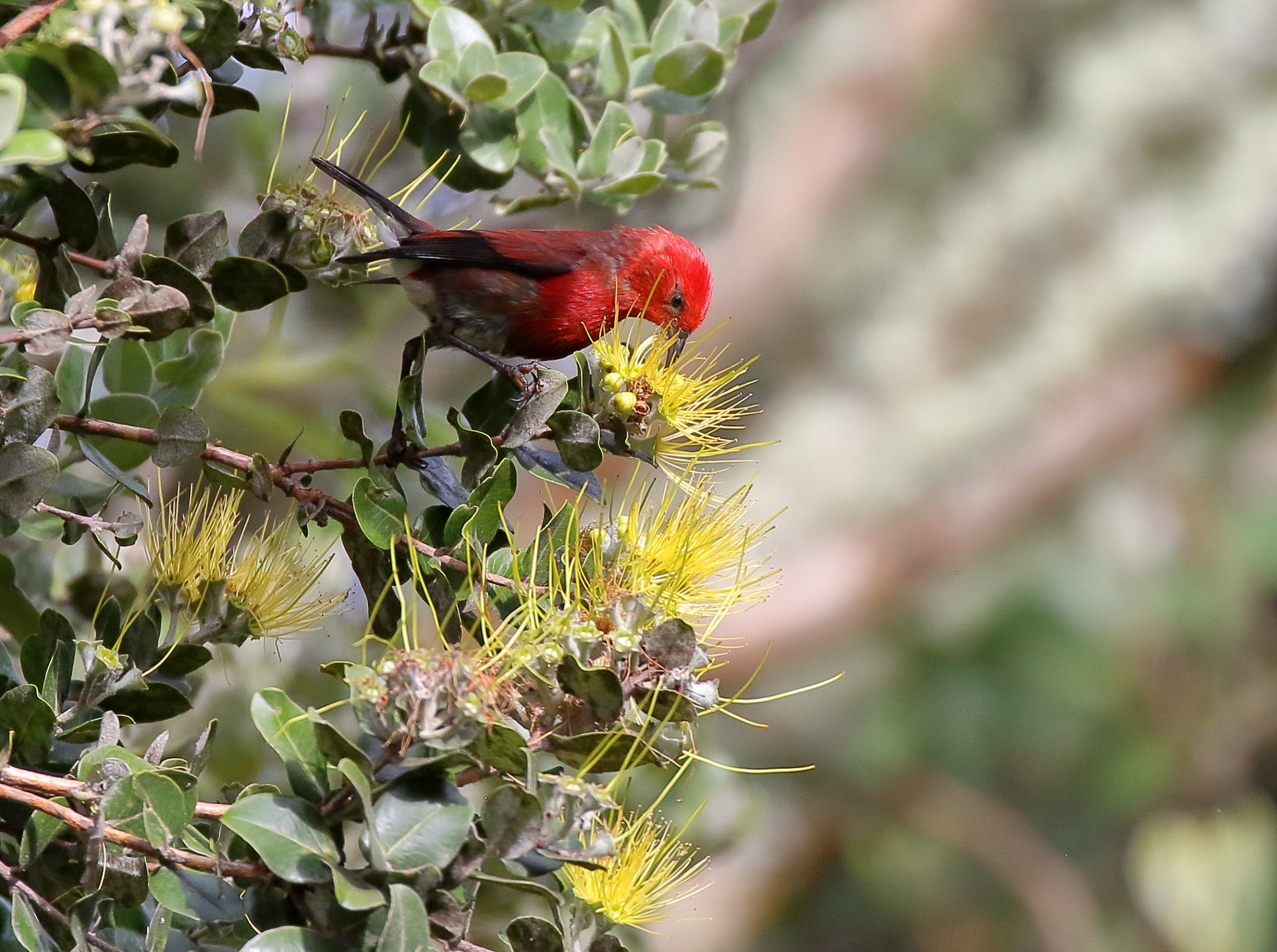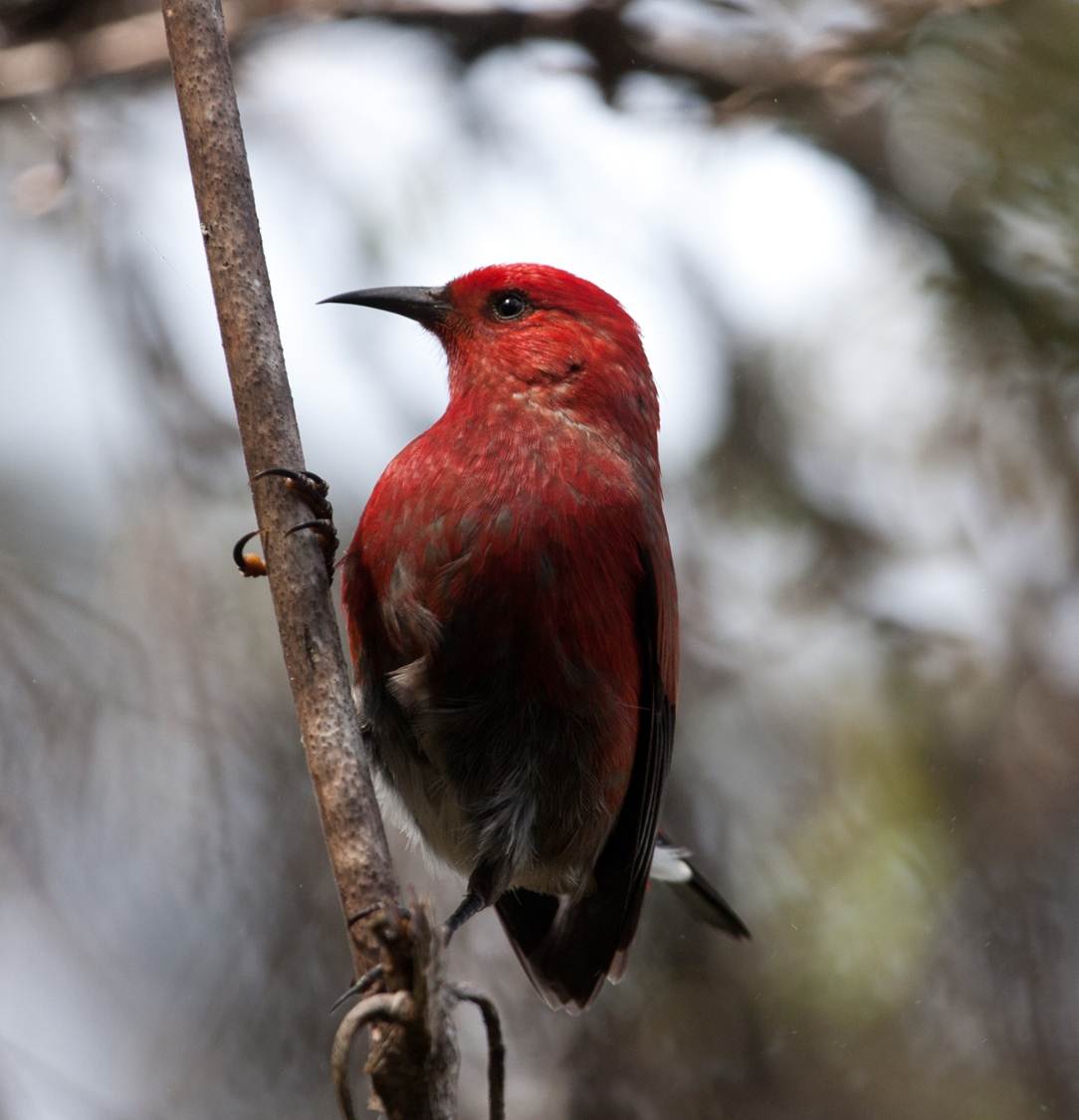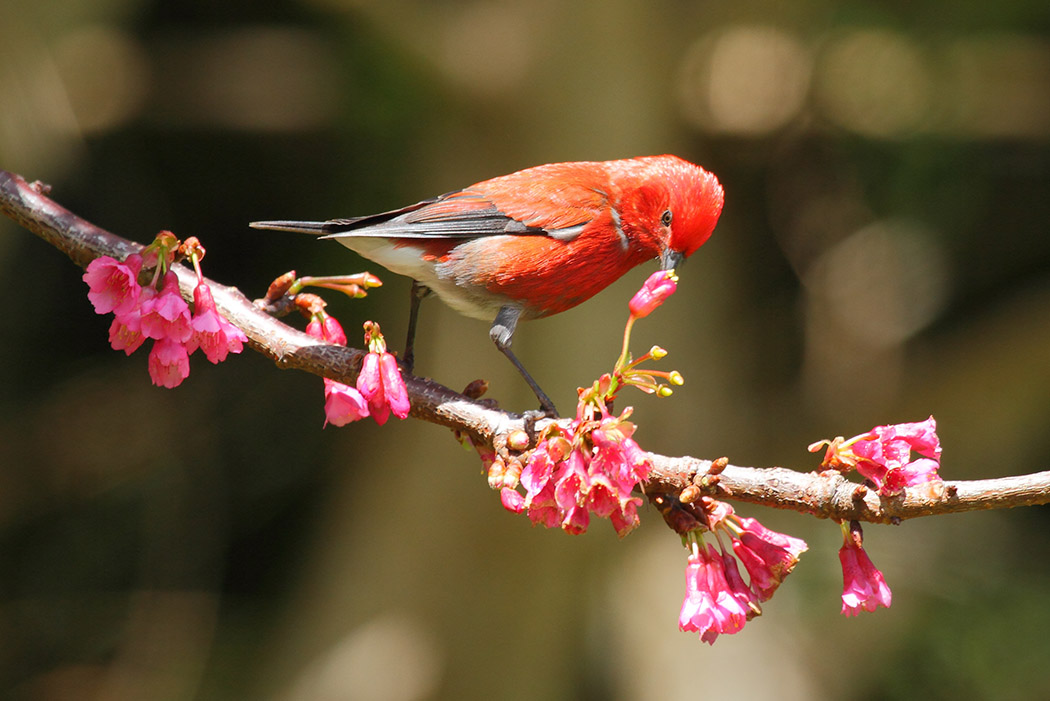ʻApapane
Names
- ʻŌlelo Hawaiʻi: ‘Apapane
- Scientific: Himatione sanguinea
Song
Conservation Status
- State Recognized as Endemic
- NatureServe Heritage Rank G3—Vulnerable
- IUCN Red List Ranking— Least Concern
Species Information

ʻApapane. PC: Bret Mossman
The ‘apapane is a small, deep rich red-colored, primarily nectarivorous Hawaiian honeycreeper (Family: Fringillidae) and is an important ‘ōhi‘a (Metrosideros polymorpha) pollinator. It is the most abundant and widely distributed Hawaiian honeycreeper, and is often seen flying above the canopy in search of patches of flowering ‘ōhi‘a. Wide-ranging movements may facilitate disease transmission among native forest birds. ‘Apapane often forage in flocks composed of their same species, likely to overwhelm ‘i‘iwi (Vestiaria coccinea) and ‘ākohekohe (Palmeria dolei), which often defend flower-rich trees. Outside the breeding season, ‘apapane also join hunting parties made up of several species. They feed on insects, which they glean from outer foliage and twigs in the upper- and mid-canopy. Sexual chasing and courtship feeding often comes before nest building, a task shared by both male and female. Pairs defend small territories around nests. Females incubate three eggs and brood young; males feed females away from the nest. Both parents feed nestlings (young bird that has not left the nest), and newly-flying birds may remain with their parents for up to four months.
Distribution
Occurs in native forests above 1,250 meters (4,100 feet) on the islands of Hawai‘i, Maui, and Kaua‘i. On O‘ahu, occurs in the Ko‘olau Range from 300 meters (975 feet) to summit at 946 meters (3,075 feet), and are less common in the Wai‘anae Range above 600 meters (1,950 feet). Rare on Moloka‘i and Lāna‘i. Historically were common at low elevations on all islands with appropriate habitat.
Habitat
Mesic and wet forests dominated by ‘ōhi‘a and koa (Acacia koa), primarily at elevations greater than 1,250 meters (4,100 feet). The primary reason for this limitation is the high density of cold-intolerant Culex mosquitoes, an important disease vector, below this elevation. Occupied habitats also contain kōlea (Myrsine lessertiana), naio (Myoporum sandwicense), and hapu‘u tree ferns (Cibotium spp.). Māmane (Sophora chrysophylla) is common in high-elevation foraging habitat. Although much of the species’ current range is under State or Federal jurisdiction, habitat protection and restoration efforts vary considerably.
Threats
Although populations appear stable on the islands of Hawai‘i, Maui, and Kaua‘i, they are likely susceptible to the same factors that threaten other native Hawaiian forest birds including habitat loss and degradation, predation by introduced mammals, and disease. For ‘apapane the following is of particular concern:
- Disease. Of Hawaii’s native forest birds, ‘apapane have the highest prevalence of avian malaria. Individuals infected with avian pox also are more likely to be infected with malaria. Foraging movements may increase their exposure to disease. ‘Apapane breed in mid-elevation forests, which suggests some disease resistance.
Plans & Projects
Additional Resources
For more information and references visit the DLNR State Wildlife Action Plan factsheets. DOFAWʻs species pages and State Wildlife Action Plan fact sheets are provided for general information and are not meant to be a citable, original source of data. If you are a student, researcher, or writer looking for a citable source, please explore the references below or find other original data sources, rather than citing these webpages. The references below were provided by the authors of the State Wildlife Action Plan fact sheets at the time of drafting:
- Fancy SG, Ralph CJ. 1997. ‘Apapane (Himatione sanguinea). In The Birds of North America, No. 296 (Poole A, Gill F, editors.). Philadelphia, (PA): The Academy of Natural Sciences; and Washington DC: The American Ornithologists’ Union.
- Foster JT, Tweed EJ, Camp RJ, Woodworth BL, Adler CD, Telfer T. 2004. Long-term population changes of native and introduced birds in the Alaka‘i swamp, Kaua‘i. Conservation Biology 18:716-725.
- IUCN Red List of Threatened Species. 2015. Version 2014.3. Available at: www.iucnredlist.org.
- Scott JM, Mountainspring S, Ramsey FL, Kepler CB. 1986. Forest bird communities of the Hawaiian islands: their dynamics, ecology and conservation. Lawrence, (KS): Cooper Ornithological Society.






